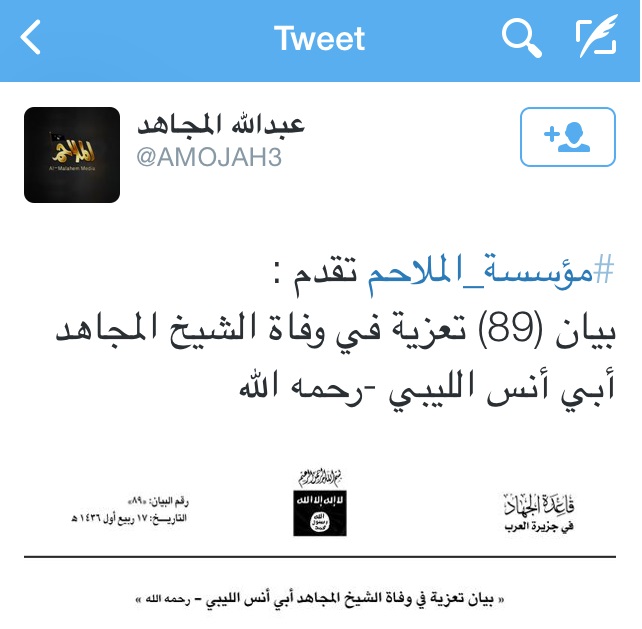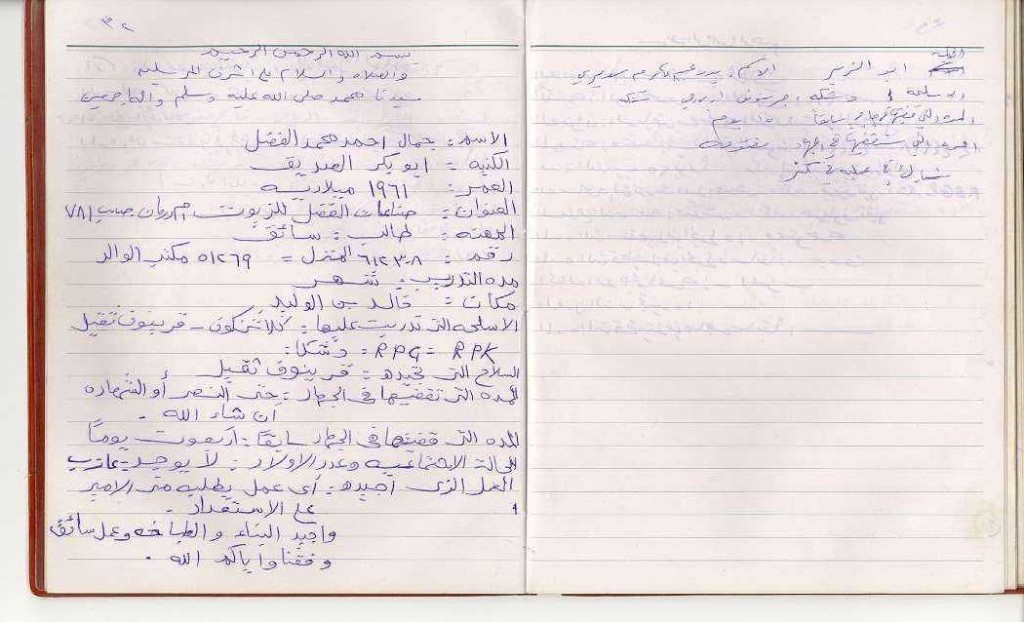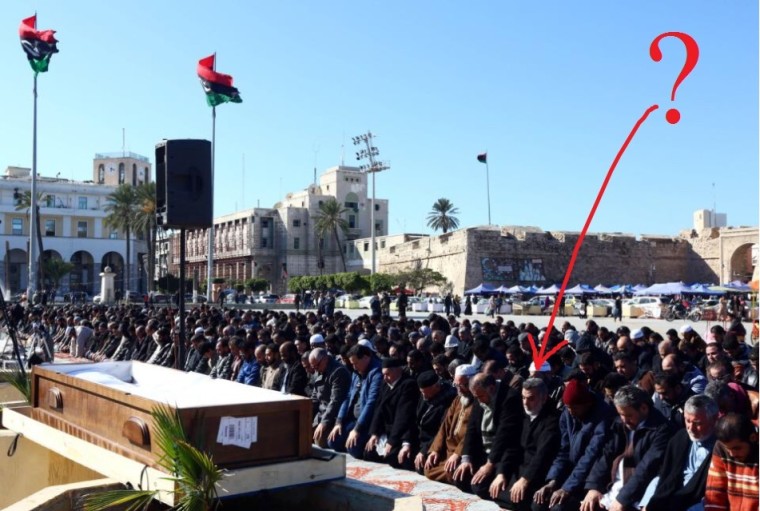OLD SCHOOL TIES — IRAN AND AL-QA’IDA
OLD SCHOOL TIES — IRAN AND AL-QA’IDA
By Michael S. Smith II
One could have expected to find IRGC-Qods Force Commander General Qassem Suleimani, who has been branded a terrorist by the United States, in attendance for the funerals of his friend IRGC Brigadier General Mohamed Ali Allah-Dadi and Suleimani’s adopted son Jihad Imad Mughniyah, both of whom were recently killed in Syria. Yet it is doubtful the White House would have approved an operation to capture or kill Suleimani during either occasion.
Meanwhile, weeks earlier — as with former IRGC chief Ahmed Vahidi’s June 2011 trip to Latin America — the US might have again missed an opportunity to arrange for the capture of a senior IRGC official labeled a terrorist by the US in relatively easy to access environs. For a photo distributed by Agence France-Presse (see above) appears to reveal that Suleimani made a trip to Libya to attend the funeral of deceased al-Qa’ida operative Anas al-Libi.
Captured in Libya in 2013, al-Libi succumbed to liver cancer while in US custody. While much attention was given to messages from al-Qa’ida’s Yemen branch regarding its role in the 7 January 2015 terrorist attack on the offices of Charlie Hebdo, the media paid little attention to the fact that the group, which is helmed by al-Qa’ida’s second-in-command, eulogized al-Libi in a message released the following day.

Screenshot: An AQAP Twitter account (now suspended) promotes AQAP’s eulogy of Anas al-Libi
Prior to his return to Libya, al-Libi enjoyed refuge in Iran for many years after al-Qa’ida attacked the US homeland in September 2001. After, that is, al-Libi found refuge in Britain in the late 1990s — despite his alleged involvement in the dual bombings of US embassies in East Africa in 1998.
Titled “Al-Qaeda in Libya: A Profile,” an August 2012 report commissioned by the Combatting Terrorism Technical Support Office covered aspects of al-Libi’s activities following his return to Libya from Iran alongside numerous other al-Qa’ida-affiliated jihadis who also played important roles in the 2011 Libyan Revolution. The report explains that al-Libi was “reportedly tasked by [Ayman] al-Zawahiri with the mission of creating an al-Qa’ida clandestine network in Libya. … Reporting indicates that intense communications from AQSL are conducted through Abu Anas al-Libi, who is believed to be an intermediary between al-Zawahiri and jihadists in Libya.” (For additional coverage of the exploitations of Iranian territory following al-Qa’ida’s 9/11 attacks of 2001 by Libyan jihadists who played prominent roles in the Libyan Revolution of 2011, see DOWNRANGE founding editor Michael S. Smith II’s December 2011 report titled “A View to Extremist Currents in Libya.”)
The DOWNRANGE team has not yet confirmed Suleimani attended the funeral for al-Libi. Yet, in the aforementioned photo taken during al-Libi’s funeral, the man seated in the front row fifth from the right bears a striking resemblance to Sulemani. Indeed, upon his review of the photo, a former intelligence official whose agency tracked Qods Force operatives advised, “If it’s not [Suleimani], it’s his twin.”
For his involvement with the Qods Force, a special forces component of the IRGC created with a mandate to help establish, fund, train, equip and provide logistical support to terrorist groups, Suleimani was among numerous Iranian officials designated by the US Treasury Department in 2007.
Then, in 2011, he was sanctioned by Treasury for helping to coordinate a failed plot to attack foreign officials and diplomatic facilities in Washington, DC. Several months prior, helmed by Suleimani at the time, the Qods Force was placed on the Annex list accompanying Executive Order 13572, “Blocking Property of Certain Persons with Respect to Human Rights Abuses in Syria.”
Also in 2011, Treasury designated half a dozen al-Qa’ida members part of a secretive al-Qa’ida facilitation network in Iran. Discussing the designations, Under Secretary for Terrorism and Financial Intelligence David S. Cohen explained, “Iran is the leading state sponsor of terrorism in the world today. By exposing Iran’s secret deal with al-Qa’ida allowing it to funnel funds and operatives through its territory, we are illuminating yet another aspect of Iran’s unmatched support for terrorism.”
In 2012, Treasury took further action against members of what Cohen described at the time as “al-Qa’ida’s critically important Iran-based funding and facilitation network.” Cohen advised that Treasury would “continue targeting this crucial source of al-Qa’ida’s funding and support, as well as highlight Iran’s ongoing complicity in this network’s operation.”
Also in 2012, Treasury designated Iran’s Ministry of Intelligence (MOIS). In its explanation for this action, Treasury noted MOIS had provided support to, among numerous terrorist elements, al-Qa’ida in Iraq, which, after being ejected from the al-Qa’ida fold in 2014, rebranded itself as the Islamic State and declared that it had established a caliphate on territories the group controls in Syria and Iraq.
However, it is the Qods Force that has managed the Iranian regime’s relations with al-Qa’ida, along with the Afghan Taliban, an enterprise founded by the jihadi to whom al-Qa’ida’s leadership has subordinated themselves thus elements of the al-Qa’ida network vis-à-vis their oaths of bayat pledged to the so-called Emir al-Mu’minin (Commander of the Faithful), Mullah Mohamed Omar. (Background on the Qods Force’s role managing relations with these Sunni-spectrum groups in “The al-Qa’ida-Qods Force Nexus: Scratching the Surface of a ‘Known Unknown’” by DOWNRANGE founding editor Michael S. Smith II, which was used as a supplement for the Countering Iran in the Western Hemisphere Act of 2012 (signed into law by President Obama in December 2012). See also “Iran and the Global Jihad: Exploring How the ‘Impossible’ Became Inevitable” by DOWNRANGE founding editors Ronald Sandee and Smith.)
Anas al-Libi was but one of dozens of high-profile al-Qa’ida operatives and leadership figures who found safe haven in Iran following the 9/11 attacks of 2001. According to information provided to the FBI in 2013 by Usama bin Laden’s son-in-law, Suleiman Abu Ghaith, one of the actual alleged masterminds of the 1998 East Africa Embassies Plot, Abu Mohamed al-Masri (aliases include Abdullah Ahmed Abdullah, or “Triple A”), was among them. The US State Department’s Rewards for Justice Program continues to advertise a $5 Million reward for information that leads to his arrest.
The regime’s permissiveness to al-Qa’ida’s post-9/11 use of Iranian territory was so great that, in Iran — far from the reach of US counterterrorism operatives — al-Qa’ida constituted its so-called “Shadow Shura.” Indeed, the regime’s post-9/11 support for al-Qa’ida has arguably done much more to ensure the viability of the al-Qa’ida network than its support prior to the turn of the century. Nevertheless, critical assistance was delivered to al-Qa’ida by the regime long before it allowed al-Qa’ida operatives to use Iranian territory as a preferred ingress and egress avenue in their travels between Afghanistan and the West while preparing to unleash attacks on the US homeland.
During the mid-1990s, senior al-Qa’ida military committee figures underwent training at Iran-sponsored facilities run by Hizballah in Lebanon. Through this training, it is believed they developed much of the knowledge base that was subsequently leveraged in 1998 to execute the dual bombings of the US Embassy Dar es Salaam and US Embassy Nairobi. The latter of which al-Libi allegedly cased years earlier to help develop the attack plot.
Some reporting on these developments was reviewed by 9/11 Commission staffers as they endeavored to produce a comprehensive report concerning, among other topics, the US intelligence community’s knowledge of al-Qa’ida’s activities and alliances prior to its September 2001 attacks on the US homeland.
According to a Time magazine report on their findings, much of the information about al-Qa’ida’s relations with the Iranian regime was gleaned during interrogations of Yemeni al-Qa’ida member Waleed Mohammed bin Attash, a bin Laden bodyguard and alleged organizer of the attack targeting the USS Cole who was eventually transferred to Guantanamo after being captured in Karachi, Pakistan in 2003. The report adds that “as many as 100 separate electronic intelligence intercepts culled by analysts at the NSA” were also reviewed by Commission staffers while exploring linkages between al-Qa’ida and the Iranian regime.
Other information that almost certainly proved valuable to these staffers is contained in transcripts of interviews and testimony provided by Jamal al-Fadl. An al-Qa’ida member turned FBI source during the 1990s, al-Fadl provided investigators detailed background information on al-Qa’ida’s activities in African during the period in which the East Africa Embassies Plot and other major attack plots were developed and mobilized.

Pages about Jamal al-Fadal contained in an early roster of al-Qa’ida members
Concerning al-Qa’ida’s 1998 attack targeting two US embassies in East Africa that killed more than 200 people — CIA’s first victims of al-Qa’ida’s attacks reportedly among them — and wounded thousands more, the Commission’s final report states (alternate transliterations of Arabic names used for consistency):
As early as January 1994, bin Laden received the surveillance reports, complete with diagrams prepared by the team’s computer specialist [Anas al-Libi]. He, his top military committee members — Banshiri and his deputy, Abu Hafs al-Masri (also known as Mohamed Atef) — and a number of other al-Qa’ida leaders reviewed the reports. Agreeing that the US embassy in Nairobi was an easy target because a car bomb could be parked close by, they began to form a plan. Al-Qa’ida had begun developing the tactical expertise for such attacks months earlier, when some of its operatives — top military committee members and several operatives who were involved with the Kenya cell among others — were sent to Hizballah training camps in Lebanon.
Bin Laden’s mentor and eventual successor, Ayman al-Zawahiri, established relations with Iranian intelligence soon after Khomeini claimed power. It is likely that he viewed ties with radical Shiites, or Khomeinists, as plausibly deniable. This, due to the centuries-old animus toward Shiites evident among conservative Sunni spheres whose members’ worldviews have been molded by the works of 13th-14th Century Islamist theoretician Taqi al-Din Ibn Taymiyyah, which are immensely important to Saudi Arabia’s Wahabbi sect. As observed by Middle East political scholar Vali Nasr in his book titled The Shia Revival: How Conflicts within Islam will Shape the Future (2006), Ibn Taymiyyah “saw the Shia as the enemy within, guilty of polluting Islam and facilitating the fall of its cherished institution of the caliphate during the Mongol invasion. He dismissed Shiism as heresy and sanctioned violence against its followers. More important, he put forth a formal Sunni refutation of Shiism that set the tone for much of the sectarian conflict even to this day.”
Similar contemplations regarding plausible deniability may have factored into the decision to aid al-Qa’ida made by Iran’s current Supreme Leader. Interestingly, however, he has openly promoted the works of Sayyed Qutb, the chief formulator of Salafiyya Jihadiyya (i.e. the ideology which informs the worldviews, thus shapes the vicious agendas of the members of groups like al-Qa’ida and other elements of the Global Jihad movement, including the al-Qa’ida offshoot known as the Islamic State). Indeed, among the accomplishments listed in Ayatollah Khameini’s official biography that is available in English online are his translations of two works by Qutb, The Future in Islamic Lands and An Indictment against the Western Civilization. (Titled Militant Ideology Atlas, an exhaustive study completed by researchers at the Combatting Terrorism Center at West Point in 2006 determined that, in the oeuvre of jihadist theorists’ works that inform the agendas of elements such as al-Qa’ida, Qutb’s are the most influential.)
Early exchanges between the government of Iran and al-Qa’ida were likely encouraged by al-Qa’ida’s current emir, Ayman al-Zawahiri, who was then managing Egyptian Islamic Jihad, which al-Zawahiri merged with al-Qa’ida just before the 9/11 attacks of 2001. Eventually, a formal relationship took shape early in 1993 during meetings in Tehran attended by four original founders of al-Qa’ida, each of them members of its Shura council: Abu Hajer al-Iraqi (jailed in the US), Abu Ayoub al-Iraqi (current status unknown), Abu Ubaidah al-Banshiri (d. 1996), and Abu Rida al-Suri (true name Mohamed Bayazid; believed to be residing in Khartoum). (Note: In a section concerning al-Qa’ida’s pursuit of nuclear and biological weapons capabilities found in his book titled At the Center of the Storm: My Years at the CIA (2007), former DCI George Tenet notes that al-Suri, a trained physicist who has held Permanent Resident status in the US and studied at the University of Arizona in the 1980s, was uncooperative when Rolf Mowatt-Larssen, then head of the Counterterrorist Center’s WMD branch, was dispatched to meet with him and another al-Qa’ida operative in Sudan in 2002. Larssen had traveled to Sudan to solicit help with thwarting what Bush Administration officials assessed to be al-Qa’ida’s aspirations to deploy WMD in the West. Accordingly, al-Suri and the other al-Qa’ida operative, identified as Mubarak al-Duri, “had developed business connections to Sudanese WMD-related entities, and both had established businesses that could have served as dual-use front companies for developing nuclear and biological weapons.” Following a request for their help with efforts to deny al-Qa’ida the means and opportunity to deploy WMD, one of the men responded, “No … I think it is legitimate to kill millions of you because of how many of us you have killed.” It is unclear if Mubarak al-Duri is the real name of or another alias used by the elusive (former) al-Qa’ida member known as Abu Ayoub al-Iraqi.)
According to Jamal al-Fadl, when bin Laden was questioned about the outcomes of the 1993 meetings in Iran by al-Qa’ida members who were ostensibly displeased with the prospects of having to collaborate with radical Shiites, bin Laden advised that “our biggest enemy is ourselves.” He added: “all Muslims must unite and defend ourselves.”
It is unlikely the operational relationship between al-Qa’ida, on the one hand, and the Iranian regime and its Shia terrorist proxy Hizballah, on the other, was cemented until al-Qa’ida members were dispatched for military training at camps in Lebanon’s Bekaa Valley, where terrorists were trained in Iran-sponsored camps to execute attacks on Western states’ facilities in Beirut a decade earlier.
When al-Qa’ida members arrived, these camps were managed by top Hizballah military figures like Imad Mughniyah. The father of Qods Force Commander Qassem Suleimani’s aforementioned adopted son who was recently killed in Syria, Mughniyah is believed to have managed various attacks on Western states’ installations in Beirut during the early 1980s. Among the plots Mughniyah is thought to have played important roles in was the 1983 bombing of the US Marine Corps barracks that killed 241 American servicemen. He was assassinated in 2008; as with the strike in Syria in January 2015 that killed his son, the assassination of Imad Mughniyah was unofficially attributed to Israeli forces.
Like the capitulation in 1979 of Iranian premier Mohamed Reza Shah Pahlavi, whom then President Jimmy Carter had depicted as America’s top regional ally about a year earlier, the October 1983 terrorist attacks that killed 241 American servicemen and prompted the withdrawal of US forces from Lebanon galvanized Sunni jihadists. According to Usama bin laden, the decampment of American forces from Lebanon signified “the decline of American power and the weakness of the American soldier, who is ready to wage cold wars but unprepared to fight long wars. This was proven in Beirut in 1983, when the Marines fled.” (See John Miller, “Exclusive Interview with Osama bin Ladin: Talking with terror’s banker,” ABC News, 28 May 1998.)
Among the prominent al-Qa’ida figures who attended training at these camps were Abu Talha al-Sudani and Saif al-Adl. Believed to have served as a colonel in Egypt’s special forces before joining the Global Jihad movement, al-Adl is also wanted by the US for his involvement in the 1998 East Africa Embassies attack. The US State Department’s Rewards for Justice Program continues to advertise a $5 Million reward for information that leads to his arrest.
Following the US invasion of Afghanistan in 2001, al-Adl assumed responsibility for moving members of the bin Laden family into Iran. A trusted Western intelligence source says credible reports emerged around this time that indicated al-Adl may have also smuggled components of al-Qa’ida’s nuclear and biological weapons program into the country.
Al-Adl, who became the head of al-Qa’ida’s military committee, may still be living on a military compound near Tehran. Life at this facility was described to the FBI by bin Laden’s son-in-law, Suleiman Abu Ghaith, after he was detained by authorities in January 2013, soon after his decampment from Iran. Gaith advised that, although the regime had implemented a policy to encourage al-Qa’ida members and other terrorists who found safe haven in Iran to return to their home countries in recent years, al-Adl elected to remain at the compound where Ghaith and various other influential al-Qa’ida figures had been living under the supervision of Iranian intelligence.
In the years that followed al-Qa’ida’s deployment of members to Lebanon for military training, like the mysterious figure known as Sheikh Mohamed Said Nou’mani, whom Iran’s Supreme Leader deployed to Sudan to manage the regime’s relations with radical Sunni elements waging jihad in Africa during the 1990s, Imad Mughniyah served as an important liaison between the regime — more specifically, the Qods Force — and al-Qa’ida’s leaders.
Taking into consideration US Treasury Department depictions as recently as 2014 of al-Qa’ida’s network in Iran as an enterprise that has in recent years been funneling money and people into Syria with the knowledge of Iranian authorities, it is ironic that Imad Mughniyah’s son was killed while possibly helping Qods Force leaders in Syria track elements of the al-Qa’ida network that have proven to be among the most effective forces combatting the forces of Tehran’s top ally, Syrian dictator Bashar al-Assad.
Meanwhile, given the “old school ties” between senior al-Qa’ida members and their close associates and various powerful Iranian regime officials who report directly to Ayatollah Khameini, it would not be surprising if Suleimani was sent by Khameini to Libya to attend Anas al-Libi’s funeral. Perhaps for no other reason than to confirm he is actually dead, thus unable to provide US officials with additional information about the regime’s sponsorship of al-Qa’ida. This, or perhaps to deliver condolences to al-Libi’s family from various al-Qa’ida leadership figures like Saif al-Adl who might still be hiding in Iran.




